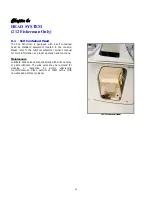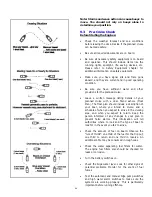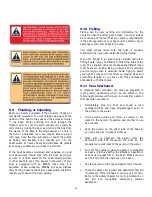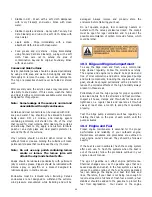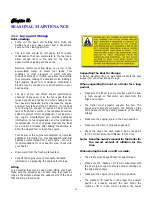
Overtaking Situations
When one motor boat is overtaking another motor boat,
the boat that is being passed has the right of way. The
overtaking boat must make the adjustments necessary
to provide clearance for a safe passage of the other
vessel. The boats should sound the appropriate signals.
The General Prudential Rule
In obeying the Rules of the Road, due regard must be
given to all dangers of navigation and collision, and to
any special circumstances, including the limitations of
the vessels, which may justify a departure from the rules
that is necessary to avoid immediate danger or a
collision.
Night Operation
Recreational boats are required to display navigation
lights between sunset and sunrise and other periods of
reduced visibility such as fog, rain, haze, etc. When
operating your boat at night you should:
• Make sure your navigation lights are on and working
properly. Navigation lights warn others of your
position and course and the position and course of
other vessels.
• All navigation rules apply. If the bow light of another
vessel shows red, you should give way to that
vessel, if it shows green, you have the right of way.
• Slow down and never operate at high speeds when
operating at night, stay clear of all boats and use
good common sense. Always be ready to slow down
or steer clear of other vessels, even if you have the
right-of-way.
• Avoid bright lights that can destroy night vision,
making it difficult to see navigation lights and the
lights of other boats. You and your passengers
should keep a sharp lookout for hazards, other boats
and navigational aids.
Navigation Aids
Aids to navigation are placed along coasts and navigable
waters as guides to mark safe water and to assist
mariners in determining their position in relation to land
and hidden dangers. Each aid to navigation is used to
provide specific information. You should be familiar with
these and any other markers used in your boating area.
43
Summary of Contents for 180 Sportsman
Page 2: ...2...
Page 4: ...4...
Page 7: ...180 FISHERMAN SPECIFICATIONS 7...
Page 8: ...180 SPORTSMAN SPECIFICATIONS 8...
Page 9: ...202 FISHERMAN SPECIFICATIONS 9...
Page 10: ...212 FISHERMAN SPECIFICATIONS 10...
Page 18: ...18...
Page 39: ...SAFETY LABELS 2601 1124 39...
Page 40: ...180 FISHERMAN 180 SPORTSMAN CAPACITY LABELS 40...
Page 41: ...202 212 FISHERMAN CAPACITY LABELS 41...
Page 61: ...Appendix A SCHEMATICS 180 FISHERMAN INSTRUMENT PANEL 61...
Page 62: ...Appendix A SCHEMATICS 180 SPORTSMAN INSTRUMENT PANEL 62...
Page 63: ...Appendix A SCHEMATICS 202 212 FISHERMAN INSTRUMENT PANEL 63...
Page 68: ...Appendix A SCHEMATICS 180 FISHERMAN 180 SPORTSMAN TRAILER DRAWING 68...
Page 69: ...Appendix A SCHEMATICS 202 212 FISHERMAN TRAILER DRAWING 69...
Page 70: ...Appendix A SCHEMATICS 180 FISHERMAN OVERHEAD LAYOUT 70...
Page 71: ...Appendix A SCHEMATICS 180 SPORTSMAN OVERHEAD LAYOUT 71...
Page 72: ...Appendix A SCHEMATICS 202 FISHERMAN OVERHEAD LAYOUT 72...
Page 73: ...Appendix A SCHEMATICS 212 FISHERMAN OVERHEAD LAYOUT 73...
Page 77: ...MAINTENANCE LOG 77...
Page 78: ...MAINTENANCE LOG 78...
Page 80: ...Appendix D BOAT ACCIDENT REPORT 80...
Page 81: ...81...
Page 87: ...Appendix F TROUBLESHOOTING GUIDE 87...
Page 88: ...TROUBLESHOOTING GUIDE 88...
Page 89: ...TROUBLESHOOTING GUIDE 89...
Page 90: ...TROUBLESHOOTING GUIDE 90...
Page 91: ...TROUBLESHOOTING GUIDE 91...






